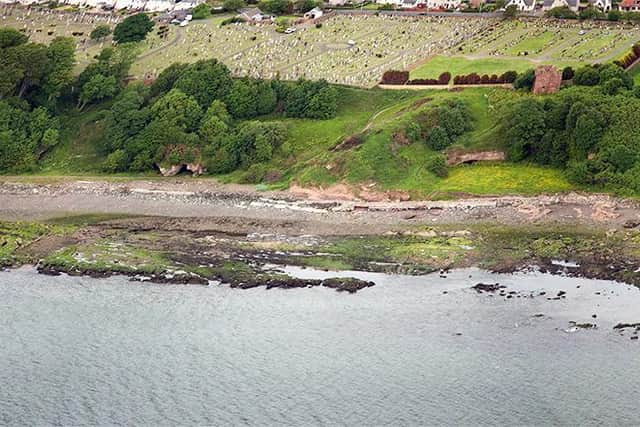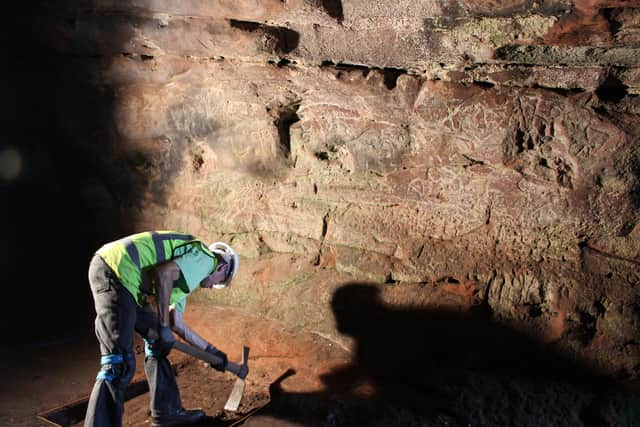Secrets of caves where Picts left their 'earliest carvings' to be unlocked


Wemyss Caves, near East Wemyss in Fife, were excavated last year with intriguing new finds and dates linked the complex to be revealed later this month.
Seven caves sit at the shoreline site with three of them – Doo Cave, Court Cave and Sliding Cave – the focus of the recent dig.
Advertisement
Hide AdAdvertisement
Hide AdPottery, animal bone and evidence of metalworking were discovered during the excavation with new radio carbon dating shedding intriguing new light on who used the caves when – and why.


Joanna Hambly, of The SCAPE Trust, which works on vulnerable coastal archaeological sites, undertook the excavation with Aberdeen University and dozens of volunteers from the surrounding communtiy.
She will reveal the latest information on the caves at a pubic meeting in East Wemyss on March 27, which has been organised by Save Wemyss Ancient Caves Society.
Ms Hambly said: “The preliminary results of the summer 2019 dig have already given us a much better understanding of how the Wemyss Caves have been used over time.”


Wemyss Caves are known to have been used during the Pictish era, probably as a Holy site and place of work, with activity at the site earlier dated to between 240 to 400 AD given barley grains found on the floor of Sliding Cave.
The caves are famous for their ancient carvings, including the largest collection of Pictish symbols found in one place in Scotland. Around 50 pictograms were discovered there in the 19th Century with 26 surviving today.
Some of the Pictish carvings found in Sliding Cave now sit among the earliest discovered. They link in date to stones found at Dunnicaer fort near Stonehaven in Aberdeenshire, which were also dated to around 250-400AD in a finding that significantly pushed back the timeline for Pictish artistry and communication.
As a result , Sliding Cave has become crucial site for the potential information it holds about the earliest origins and the use of Pictish symbols.
Advertisement
Hide AdAdvertisement
Hide AdMs Hambly said: “Here we are looking at the development of Pictish symbol stones. Standing stones starting to appear around 100 years later but these carvings are much more informal.
“A single person would normally be commissioned to create a standing stone but by then the symbol stone system was in place. You can see the beginning of that system at Wemyss Cave.”
Although great interest surrounds the Pictish era at Wemyss Caves, it is known that they have been used through time until very recently with net mending, stabling of animals and workshops once finding a home here.
Ms Hambly said it was unlikely that the caves were used as permanent residences.
She added: “People were almost certainly not living here permanently. Caves are lived in during all periods in times of crisis, really when people don’t have anywhere else to go.”
Fragments of pottery were found during the recent excavation with the pieces of jug dating to the between the 12th and 14th Century.
English in origin, it is likely to vessels were linked to nearby MacDuff Castle, which has links to the powerful Earls of Fife.
Wemyss Caves have been under threat from both subsidence caused by mining in the area to rising sea levels and changes in the coastal environment.
Advertisement
Hide AdAdvertisement
Hide AdMs Hambly said: “The caves are vulnerable from coastal change and all of the caves now have some sort of protective walling in place.
“Most people are working on the assumption that the sea level will have risen by 90 centimetres by the end of the century. That will certainly have an impact on Wemyss Caves. During high tides and storm events, they will become very vulnerable.”
However, Ms Hambly said the biggest threat to the preservation of the caves came from humans.
She said: “They is lots of anti-social behaviour at the caves, which are vulnerable to people lighting fires and chiselling their own carvings into the walls. There is a lot of graffiti there. People are now more of a threat than the sea.”
Ms Hambly said they were now “very seriously” looking into putting barriers over the caves at night to protect them.
She added: “In the 1990s, come of the caves had barriers but they didn’t last long. Now we are looking at putting up barriers that are better designed but will only be closed at night. We don’t want to stop people going into the caves. The real issue is people have parties there at night in the summer time.”
Ms Hambly will speak at Rosie and McDuff Community Hall, Alexander St, East Wemyss, on Friday, March 27 at 7pm.
Tickets are available here www.eventbrite.co.uk.
